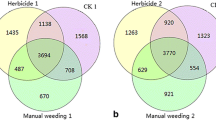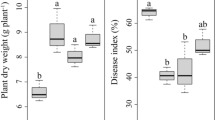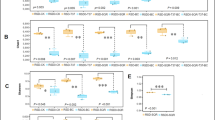Abstract
The extent of soil microbial diversity in agricultural soils is critical to the maintenance of soil health and quality. The aim of this study was to investigate the influence of land use intensification on soil microbial diversity and thus the level of soil suppressiveness of cucumber Fusarium wilt. We examined three typical microbial populations, Bacillus spp., Pseudomonas spp. and Fuasarium oxysporum, and bacterial functional diversity in soils from three different land use types in China’s Yangtze River Delta, and related those to suppressiveness of cucumber Fusarium wilt. The land use types were a traditional rice wheat (or rape) rotation land, an open field vegetable land, and a polytunnel greenhouse vegetable land that had been transformed from the above two land use types since 1995. Results generated from the field soils showed similar counts for Bacillus spp. (log 5.87–6.01 CFU g−1 dw soil) among the three soils of different land use types, significantly lower counts for Pseudomonas spp. (log 5.44 CFU g−1 dw soil) in the polytunnel greenhouse vegetable land whilst significantly lower counts for Fusarium oxysporum (log 3.21 CFU g−1 dw soil) in the traditional rice wheat (or rape) rotation land. A significant lower dehydrogenase activity (33.56 mg TPF kg−1 dw day−1) was observed in the polytunnel greenhouse vegetable land. Community level physiological profiles (CLPP) of the bacterial communities in soils showed that the average well color development (AWCD) and three functional diversity indices of Shannon index (H′), Simpson index (D) and McIntosh index (U) at 96 h incubation in BIOLOG Eco Micro plates were significantly lower in the polytunnel greenhouse vegetable land than in both the traditional rice wheat (or rape) rotation land and the open field vegetable land. A further greenhouse experiment with the air-dried and sieved soils displayed significantly lower plant growth parameters of 10-old cucumber seedlings as well as significantly lower biomass and total fresh fruit yield at the end of harvesting at day 70 in the polytunnel greenhouse vegetable soil sources. The percentages of Fusarium wilt plant death were greatly increased in the polytunnel greenhouse vegetable plants, irrespective of being inoculated with or without Fusarium oxysporum f. sp. cucumerinum. Our results could provide a better understanding of the effects of land use intensification on soil microbial population and functional diversity as well as the level of soil suppressiveness of cucumber Fusarium wilt.


Similar content being viewed by others
References
Abawi GS, Wildmer TL (2000) Impact of soil health management practices on soilborne pathogens, nematodes and root diseases of vegetable crops. Appl Soil Ecol 15:37–47
Ahn IP, Chung HS, Lee YH (1997) Vegetative compatibility groups and pathogenicity among isolates of Fusarium oxysporum f. sp. cucumerinum. Plant Dis 82:244–246
Armstrong GM, Armstrong JK (1981) Formae specilaes and races of Fusarium oxysporum causing wilt diseases. In: Nelson PE, Toussoun TA, Cook RJ (eds) Fusarium: disease, biology, and taxonomy. Pennsylvania State University Press, University Park, USA, pp 391–399
Campbell CD, Grayston SJ, Hirst DJ (1997) Use of rhizosphere carbon sources in sole carbon source tests to discriminate soil microbial communities. J Microbiol Methods 30:33–41
Carney KM, Matson PA, Bohannan BJM (2004) Diversity and composition of tropical soil nitrifiers across a plant diversity gradient and among land-use types. Ecol Lett 7:684–694
Dick WA, Tabatabai MA (1992) Significance and potential use of soil enzymes. In: Metting FB Jr (eds) Soil microbial ecology: application and environmental management. Marcel Dekker, New York, USA, pp 99–110
Dong YH, Gusti AR, Zhang Q, Xu JL, Zhang LH (2002) Identification of quorum-quenching N-acyl homoserine lactone enzymes from Bacillus species. Appl Environ Microbiol 68:1754–1759
Doran JW, Zeiss MR (2000) Soil health and sustainability: managing the biotic component of soil quality. Appl Soil Ecol 15:3–11
Fravel D, Olivain C, Alabouvette C (2003) Fusarium oxysporum and its biocontrol. New Phytol 157:493–502
Gagués S, Cotxarrera L, Alegre L, Trillas MI (2002) Limitations to photosynthesis in tomato leaves induced by Fusarium wilt. New Phytol 154:461–470
Garbeva P, Van Veen JA, Van Elsas JD (2003) Predominant Bacillus spp. in agricultural soil under different management regimes detected via PCR-DGGE. Microbiol Ecol 45:302–316
Garbeva P, Van Veen JA, Van Elsas JD (2004a) Microbial diversity in soil: selection of microbial populations by plant and soil type and implications for soil suppressiveness. Annu Rev of Phytopathol 42:243–270
Garbeva P, Van Veen JA, Van Elsas JD (2004b) Assessment of the diversity, and antagonists towards Rhizoctonia solani AG3, of Pseudomonas species in soil from different agricultural regimes. FEMS Microbiol Ecol 47:51–64
Garbeva P, Postma J, Van Veen JA, Van Elsas JD (2006) Effect of above-ground plant species on soil microbial community structure and its impact on suppression of Rhizoctonia solani AG3. Environ Microbiol 8:233–246
García-Oliva F, Masera OR (2004) Assessment and measurement issues related to soil carbon sequestration in land-use, land-use change, and forestry (LULUCF) projects under the Kyoto protocol. Clim Change 65:347–364
Garland JL, Mills AL (1991) Classification and characterization of heterotrophic microbial communities on the basis of patterns of community-level-sole- carbon-source-utilization. Appl Environ Microbiol 57:2351–2359
Gong ZT (1999) Chinese soil taxonomy. Science Press, Beijing, China, pp 147–196
Gould WD, Hagedorn C, Bardinelli TR, Zablotowicz RM (1985) Selective media for enumeration and recovery of fluorescent Pseudomonads from various habitats. Appl Environ Microbiol 49:28–32
Houghton RA (1995) Land use change and the carbon cycle. Global Change Biol 1:275–287
Institute of Soil Science, Chinese Academy of Sciences (1985) Methodology for soil microorganisms research. Science Press, Beijing, China, pp 44
IUSS Working Group WRB (2006) World reference base for soil resources 2006. World Soil Resources Reports No. 103, FAO, Rome, Italy, pp 71–72
Janvier C, Villeneuve F, Alabouvette C, Edel-Hermann V, Mateille T, Steinberg C (2007) Soil health through soil disease suppression: which strategy from descriptors to indicators? Soil Biol Biochem 39:1–23
Karlen DL, Mausbach MJ, Doran JW, Cline RG, Harris RF, Schuman GE (1997) Soil quality: a concept, definition, and framework for evaluation. Soil Sci Soc Am J 61:4–10
Kaye JP, Mcculley RL, Burke IC (2005) Carbon fluxes, nitrogen cycling, and soil microbial communities in adjacent urban, native and agricultural ecosystems. Global Change Biol 11:575–587
Kennedy AC, Smith KL (1995) Soil microbial diversity and sustainability of agricultural soil. Plant Soil 170:75–86
Komada H (1975) Development of a selective medium for quantitative isolation of Fusarium oxysporum from natural soil. Rev Plant Protect Res 8:114–125
Kong CH, Xu XH, Zhou B, Hu F, Zhang CX, Zhang MX (2004) Two compounds from allelopathic rice accession and their inhibitory activity on weeds and fungal pathogens. Phytochemistry 65:1123–1128
Kong XB, Zhang FR, Wei Q, Xu Y, Hui JG (2006) Infuence of land use change on soil nutrients in an intensive agricultural region of North China. Soil Till Res 88:85–94
Li WQ, Zhang M, Van Der Zee S (2001) Salt contents in soils under plastic greenhouse gardening in China. Pedosphere 2:359–367
Lin XG, Yin R, Zhang HY, Huang JF, Chen RR, Cao ZH (2004) Changes of soil microbiological properties caused by land use changing from rice-wheat rotation to vegetable cultivation. Environ Geochem Health 26:119–128
Lorenzini G, Guidi L, Nali C, Ciompi S, Soldatini GF (1997) Photosynthetic response of tomato plants to vascular wilt diseases. Plant Sci 124:143–152
Nitta T (1991) Diversity of root fungal floras: its applications for soil-borne diseases and crop growth. J Agric Res 25:6–11
Paul EA (2007) Soil microbiology, ecology, and biochemistry (3rd edn). Academic, San Diego, USA, p 532
Ramos C, Agut A, Lidon AL (2002) Nitrate leaching in important horticultural crops of the Valencian Community region (Spain). Environ Pollut 118:215–223
Steenwerth KL, Jackson LE, Calderón FJ, Scow KM, Rolston DE (2005) Response of microbial community composition and activity in agricultural and grassland soils after a simulated rainfall. Soil Biol Biochem 37:2249–2262
Stites W, Kraft GJ (2001) Nitrate and chloride loading to groundwater from an irrigated north-central US sand-plain vegetable field. J Environ Qual 30:1176–1184
Ter Braak CJF (1986) Canonical correspondence analysis: a new eigenvector technique for multivariate direct gradient analysis. Ecology 67:1167–1179
Vakalounakis DJ, Wang Z, Fragkiadakis GA, Skaracis GN, Li DB (2004) Characterization of Fusarium oxysporum isolates obtained from cucumber (Cucumis sativus) in China by pathogenicity, VCGs and RAPD. Plant Dis 88:645–649
Wieland G, Neumann R, Backhaus H (2001) Variation of microbial communities in soil, rhizosphere, and rhizoplane in response to crop species, soil type, and crop development. Appl Environ Microbiol 67:5949–5854
Wu FZ, Zheng WX (2006) Effect of p-hydroxybenzoic and cinnamic acids on soil fungi (Fusarium oxysporum f. sp. cucumerinum) growth and microbial population. Allelopathy J 18:129–139
Yao HY, Bowman D, Shi W (2006a) Soil microbial community structure and diversity in a turfgrass chronosequence: Land-use change versus turfgrass management. Appl Soil Ecol 34:209–218
Yao HY, Jiao XD, Wu FZ (2006b) Effects of continuous cucumber cropping and alternative rotations under protected cultivation on soil microbial community diversity. Plant Soil 284:195–203
Ye SF, Yu JQ, Peng YH, Zheng JH, Zou LY (2004) Incidence of Fusarium wilt in Cucumis sativus L. is promoted by cinnamic acid, an autotoxin in root exudates. Plant Soil 263:143–150
Ye SF, Zhou YH, Sun Y, Zou LY, Yu JQ (2006) Cinnamic acid causes oxidative stress in cucumber roots, and promotes incidence of Fusarium wilt. Environ Exp Bot 56:255–262
Yu JQ, Matsui Y (2004) Effects of root exudates of cucumber (Cucumis sativus) and allelochemicals on ion uptake by cucumber seedling. J Chem Ecol 23:817–827
Yu JQ, Shou SY, Qian YR, Zhu ZJ, Hu WH (2000) Autotoxic potential of cucurbit crops. Plant Soil 223:147–151
Zak JC, Willig MR, Moorhead DL, Wildman HG (1994) Functional diversity of microbial communities: a quantitive approach. Soil Biol Biochem 26:1101–1108
Zhang WL, Tian ZX, Zhang N, Li XQ (1996) Nitrate pollution of groundwater in northern China. Agric Ecosyst Environ 59:223–231
Zhang YG, Zhang XQ, Liu XD, Xiao Y, Qu LJ, Wu LY, Zhou JZ (2007) Microarray-based analysis of changes in diversity of microbial genes involved in organic carbon decomposition following land use/cover changes. FEMS Microbiol Lett 266:144–151
Zhu JH, Li XL, Christie P, Li JL (2005) Environmental implications of low nitrogen use efficiency in excessively fertilized hot pepper (Capsicum frutescens L.) cropping systems. Agric Ecosyst Environ 111:70–80
Acknowledgements
This work was supported by a Knowledge Innovation Project of the Chinese Academy of Sciences (No. Kzcx3-sw-439). The authors thank two anonymous reviewers for their valuable comments and suggestions that had improved this manuscript greatly. The authors also thank Yahong Wei from Northwest Sci-Tech University of Agriculture and Forestry, China, for supplying the strain of Fusarium oxysporum f. sp. cucumerinum.
Author information
Authors and Affiliations
Corresponding author
Additional information
Responsible Editor: Harsh P. Bais.
Rights and permissions
About this article
Cite this article
Shen, W., Lin, X., Gao, N. et al. Land use intensification affects soil microbial populations, functional diversity and related suppressiveness of cucumber Fusarium wilt in China’s Yangtze River Delta. Plant Soil 306, 117–127 (2008). https://doi.org/10.1007/s11104-007-9472-5
Received:
Accepted:
Published:
Issue Date:
DOI: https://doi.org/10.1007/s11104-007-9472-5




